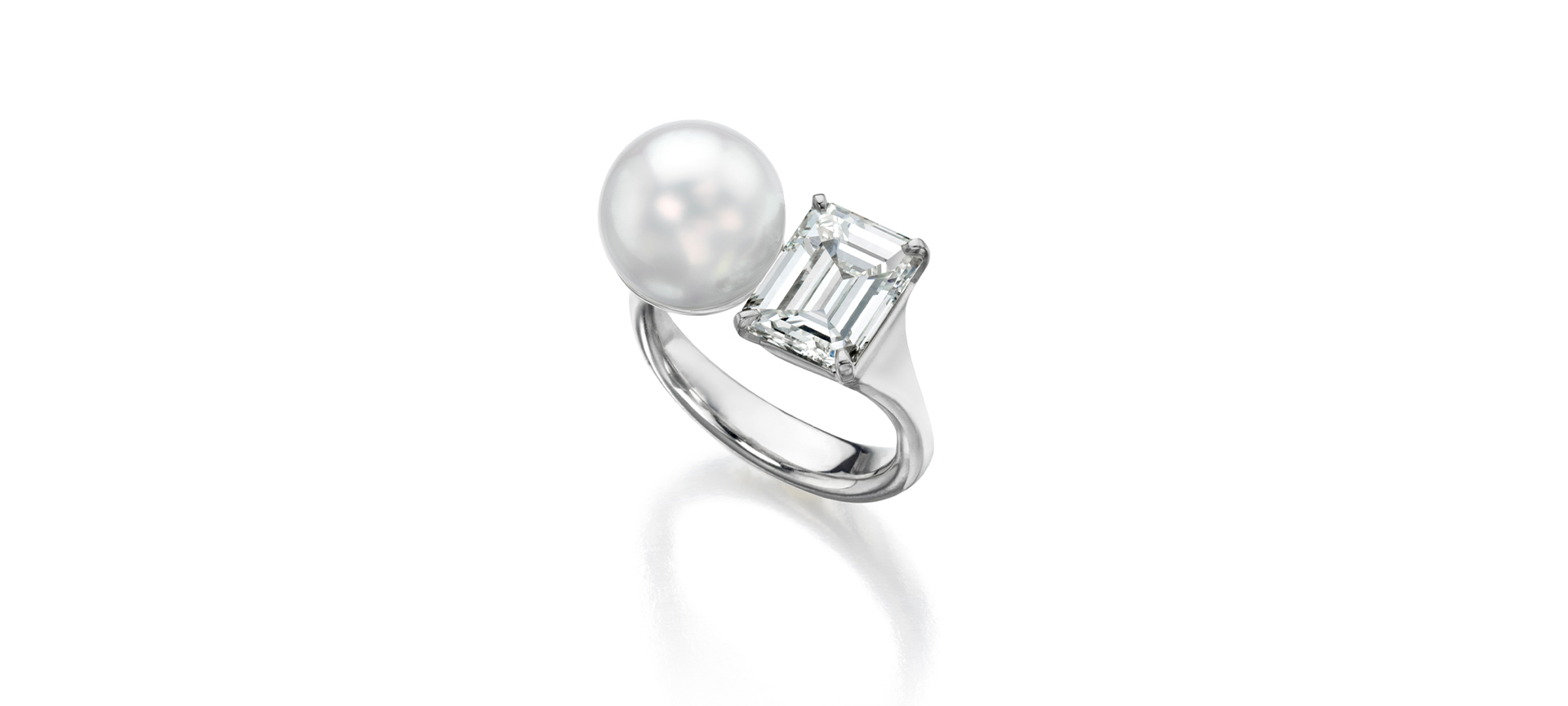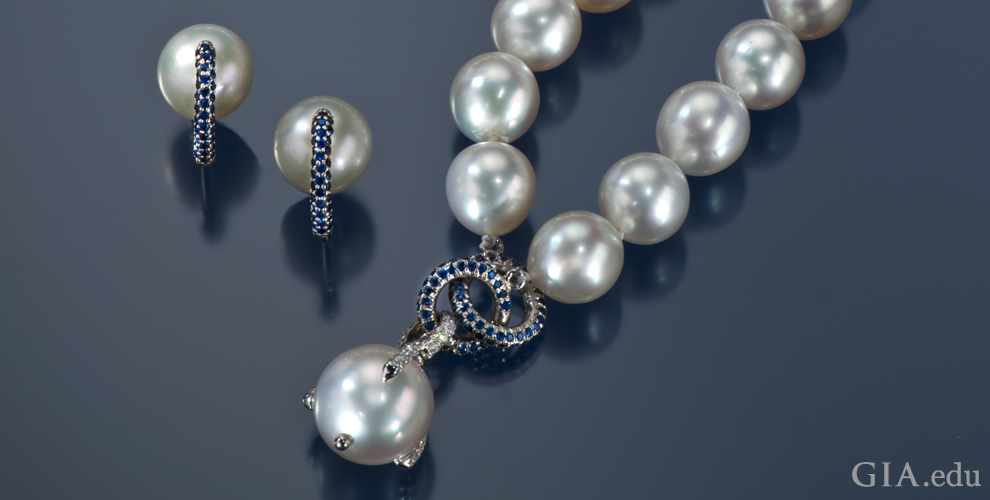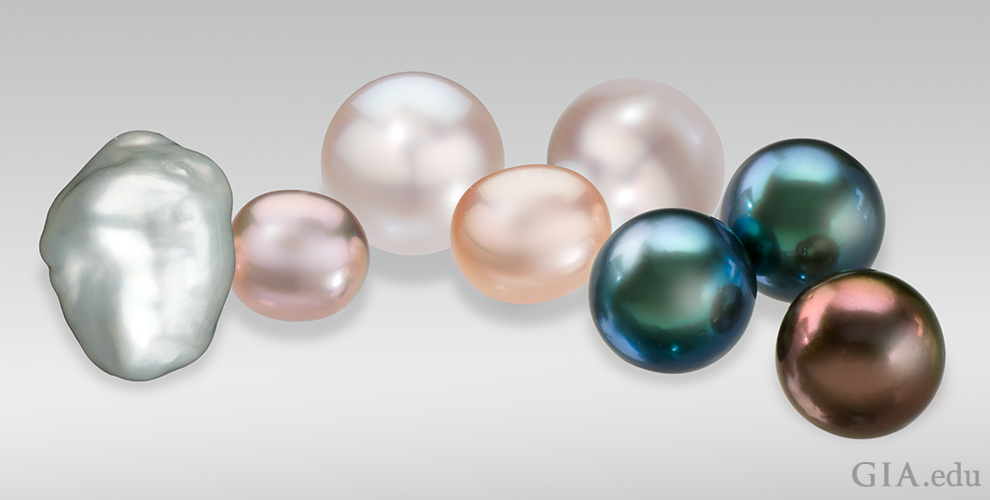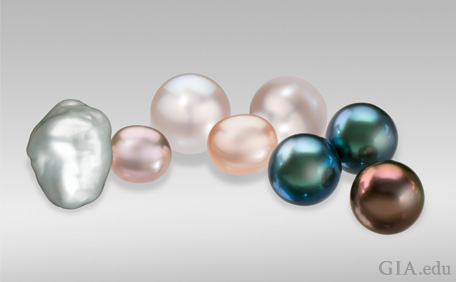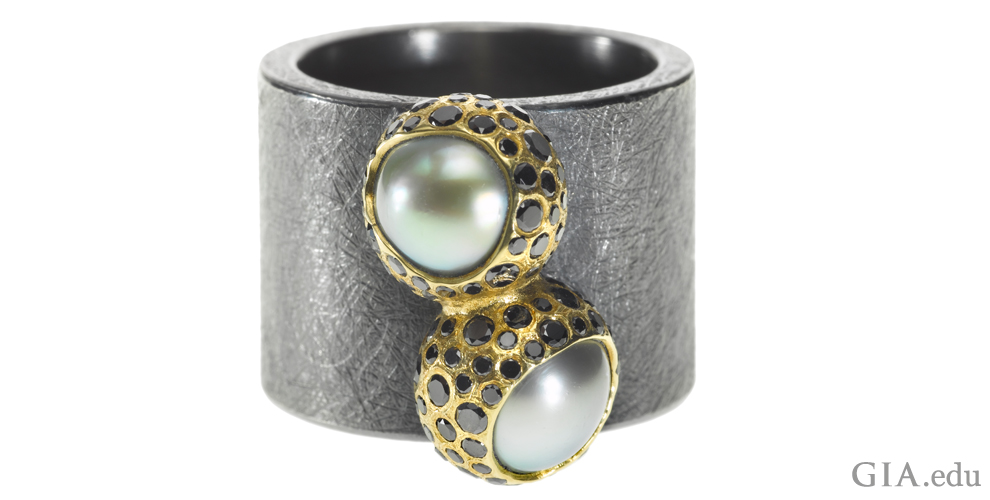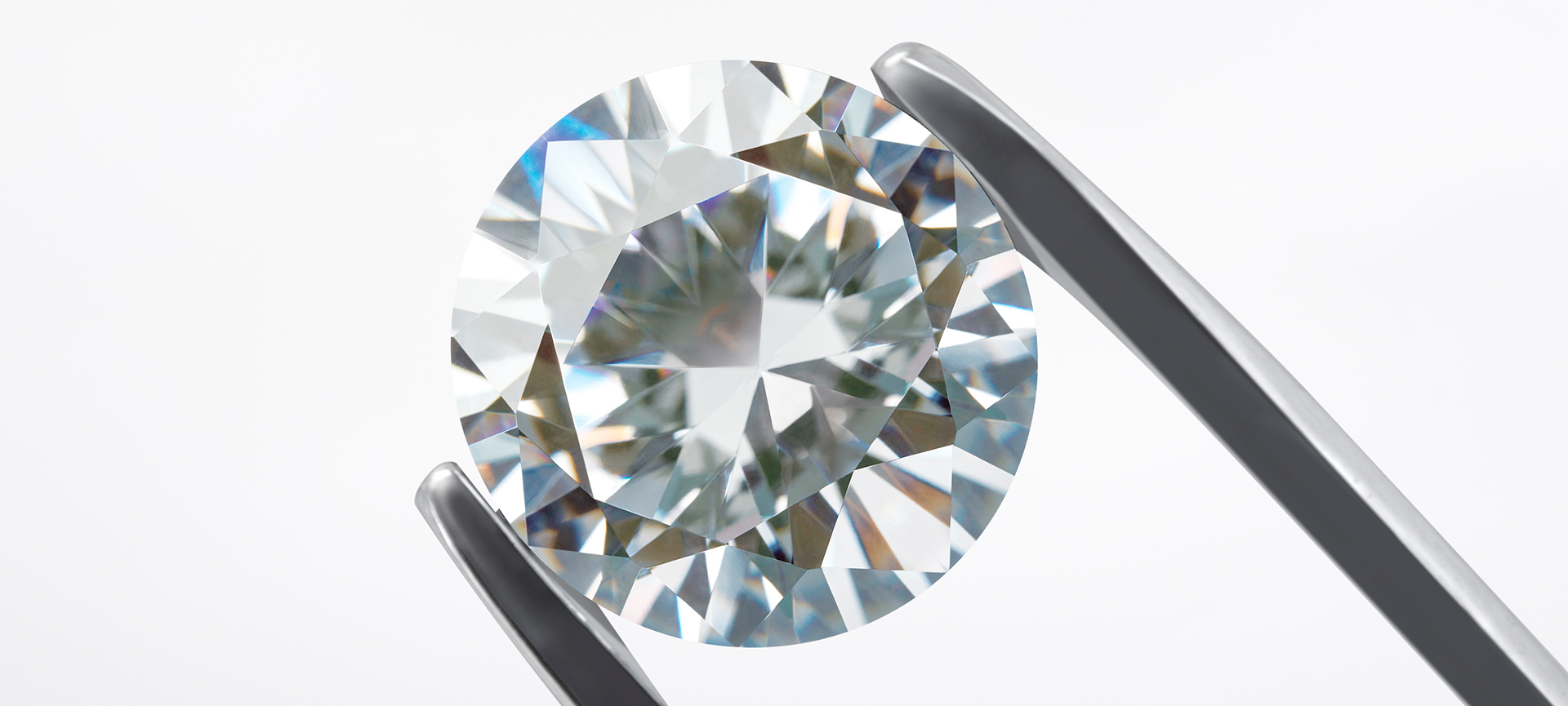Coveted for millennia, the June birthstone still reigns supreme as the queen of modern fashion. Elegant, stylish and organic, pearls come in a rainbow of colors and a range of shapes. Our pearl primer will help you choose beautiful ones.
In this post, we cover:
What Is a Pearl?
Akoya, Tahitian, South Sea and Freshwater Cultured Pearls
Pearl History and Lore
Where Pearls Come From
Pearl Qualities to Look For
Pearl Care and Cleaning

Faceted pearls are not your traditional cultured pearls. These avant-garde beauties can have 200+ facets on their surface. Photo: Robert Weldon/GIA. Courtesy: Victor Tuzlukov
June Birthstone: What Is a Pearl?
A pearl is an organic gem that grows inside saltwater and freshwater mollusks. These soft-bodied animals possess one (univalve) or two (bivalve) shells. Mollusks are invertebrates, meaning they lack a spine or vertebrae.
Gemologists divide the June birthstone into two categories:
- Natural Pearls: Pearls form without human intervention. When an irritant enters a mollusk, the mollusk secretes a mixture of calcium carbonate and conchiolin (called nacre). Like a protective shell, the nacre covers the irritant. Although used for adornment for thousands of years, today natural pearls are extremely rare and make up only a small fraction of total pearl sales.

Natural pearls are the focal point in this necklace from the Edwardian era. Photo: Robert Weldon/GIA
- Cultured Pearls: These are a product of human intervention. Technicians implant a piece of mantle tissue alone (common for freshwater cultured pearls) or with a mother-of-pearl shell bead (all saltwater) into a host mollusk. The mollusk covers the irritant with nacre, just like a natural pearl. Cultured pearls are raised in pearl farms – saltwater or freshwater operations where the mollusks are cleaned, protected from predators and eventually harvested. Cultured pearls account for the vast majority of pearl sales.
Cultured Pearls: Akoya, Tahitian, South Sea and Freshwater
Scientists estimate there are more than 100,000 different species of mollusks in the world’s waters. However, only a few dozen of these species produce the June birthstone and only about half of them are used to produce cultured pearls. Cultured pearls are classified by the species of mollusks that produce them.
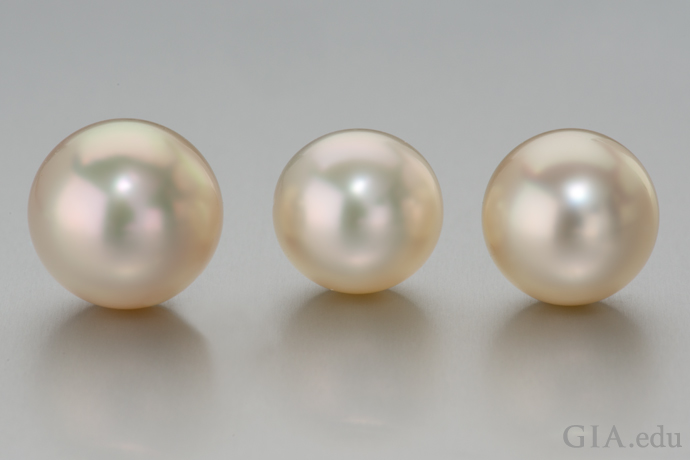
Akoya cultured pearls have an undeniable elegance. Photo: Robert Weldon/GIA
Akoya Cultured Pearls: The saltwater Pinctada fucata oyster produces white and cream-colored cultured pearls, generally between 2 and 11 mm in diameter, with the average being 6 to 8 mm. Akoya cultured pearls are often perfectly round and have a high luster (the light reflected from or near the pearl’s surface). Most akoya cultured pearls are commercially produced in Japan and China.

The many different colors of Tahitian cultured pearls are on display in this exceptional necklace, which features 27 cultured pearls that range from 13 to 19 mm. Photo: Robert Weldon/GIA. Courtesy: A Private Collector and Mona Lee Nesseth, Custom Estate Jewels
Tahitian Cultured Pearls: Famous for their exotic, almost luminescent colors, these are the product of the saltwater Pinctada margaritifera oyster, which is native to the islands of French Polynesia. The mollusk produces pearls in bodycolors sometimes described in the trade with names like aubergine (dark grayish purple), pistachio (yellowish green to greenish yellow), or peacock (dark green-gray to blue-gray, with pink to purple overtones). Tahitian cultured pearls generally range from 9 to 14 mm in diameter, most commonly 9 to 11 mm.

This necklace of semi-round South Sea cultured pearls with blue sapphire accents makes a breathtaking statement. Photo: Robert Weldon/GIA. Courtesy: Atelier Marisa
South Sea Cultured Pearls: The Pinctada maxima oyster is the largest of all saltwater cultured pearl oysters, and it can produce pearls from 8 to 20 mm in diameter; the average is 13 mm. There are two types of Pinctada maxima oysters: silver-lipped and gold-lipped. The silver-lipped oyster produces pearls that are mostly white to silver, sometimes with pink, blue or green overtones. The gold-lipped oyster produces mostly yellow to orangy yellow pearls, called “gold” or “golden” in the trade.
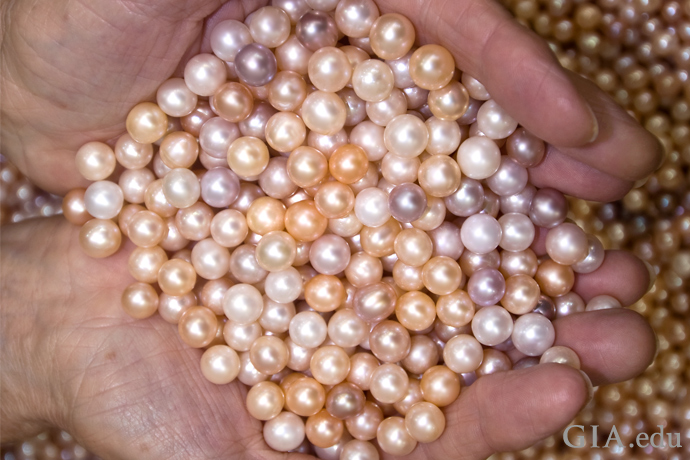
Pearls come in many colors, like these freshwater cultured pearls from China. Photo: Robert Weldon/GIA
Freshwater Cultured Pearls: From the mussel Hyriopsis cumingii or a hybrid, these pearls are produced primarily in the lakes, ponds and rivers of China. They come in many shapes, sizes (up to about 20 mm) and natural colors, including white, orange, lavender and purple. They are also dyed in a wide array of colors.
Gemologists love the June birthstone because of its luster – the reflection of light off its surface, and from concentric layers of nacre, like light bouncing off a convex mirror. Pearl’s texture also fascinates: Natural and cultured pearls have a slightly rough feeling when rubbed against your teeth, while imitation pearls are smooth. However, gemologists use X-rays to examine a pearl’s inner structure, which allows them to conclusively separate natural from cultured pearls.
June Birthstone: Pearl History and Lore
The origin of pearls fascinated our forebearers. Ancients from the Middle East believed that pearls were teardrops fallen from heaven. The Chinese fancied that the June birthstone came from the brain of a dragon. Christopher Columbus and his contemporaries thought that mollusks formed pearls from dew drops.
Pearls have long been associated with purity, humility and innocence. So it may be said that the June birthstone meaning is “sweet simplicity.” As such, pearls were traditionally given as a wedding gift.
The June birthstone was also thought to have beneficial properties. In the ancient Sanskrit text, the Atharvaveda, pearls were said to bestow long life and prosperity. In Asia, pearls were believed to help alleviate indigestion and hemorrhages. Arab physicians in the 1820s maintained that pearl powder improved eyesight, quieted nervous tremors and eased depression.
One of the most famous natural pearls is the 50.56 carat (ct) La Peregrina. About the size of a pigeon’s egg, the pearl was discovered in the 1500s in the Gulf of Panama. It became a prized possession of European royalty. Richard Burton eventually gifted it to Elizabeth Taylor in 1969; Christie’s New York auctioned it in 2011 for $11.8 million.
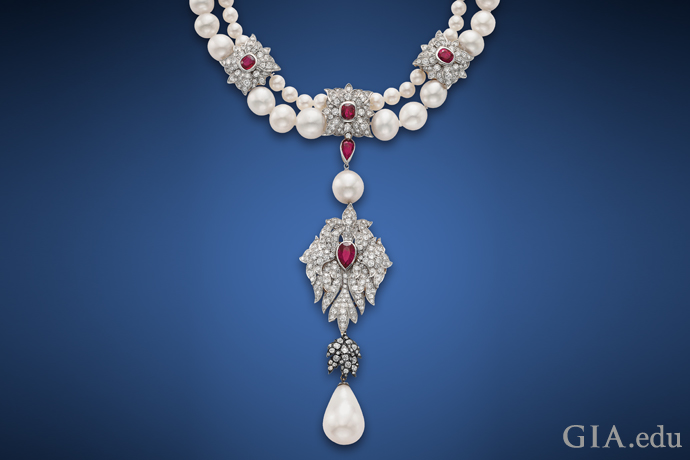
Literally a royal gem, Elizabeth Taylor’s 50.56 ct La Peregrina pearl was owned by eight Spanish kings, from Philip II (1582-1598) to Carlos IV (1778-1808). Cartier set the pearl as part of the pendant in this two-strand necklace that has 56 saltwater natural pearls, four cultured pearls, rubies and diamonds. Courtesy: Christie’s
June Birthstone: Where Pearls Come From
You’ll have to set sail for pristine waters if you want to find the June birthstone. Pearl-bearing mollusks fail to thrive in polluted waters, so pearl farms are usually located far from civilization – and often in breathtaking settings.
Saltwater pearls are grown in many areas around the world. Akoya cultured pearl farms are primarily found in Japan and China, especially along the southern coasts of Guangdong and Guangxi provinces. South Sea cultured pearls are farmed from the northern coast of Australia through Indonesia to the southern coast of Southeast Asia, with large operations in the Philippines as well. The Gambier Islands and the Tuamotu Archipelago, both part of French Polynesia, are two locales where the rich black Tahitian pearls are cultured.
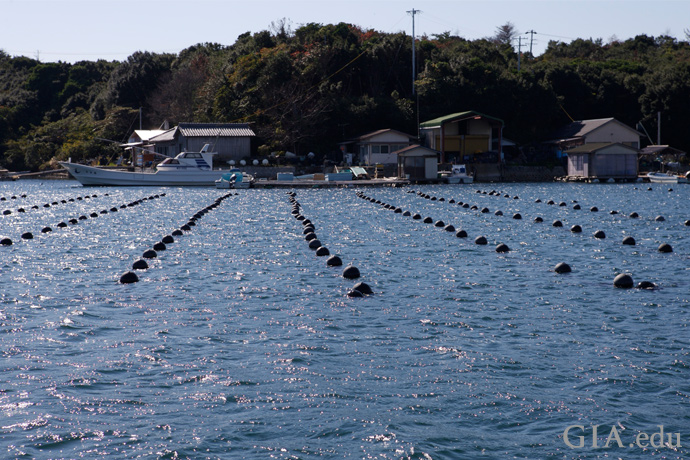
Ago Bay, Japan is one of the most important sites for akoya cultured pearl farms. Photo: Valerie Power/GIA
Freshwater cultured pearls are primarily grown in China, within a 400 mile (644 km) radius of Shanghai.
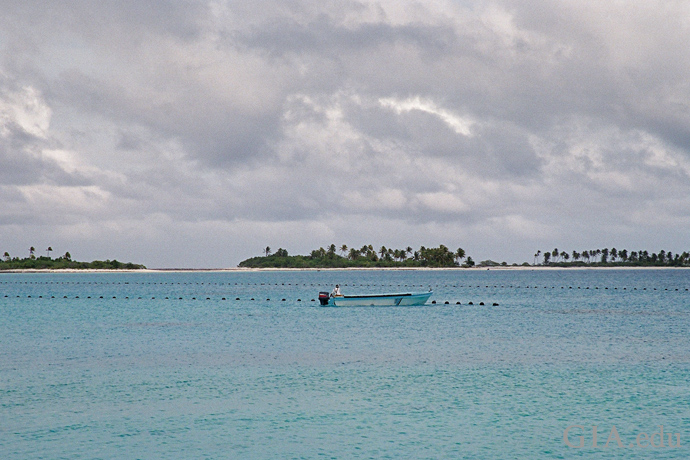
The breeding waters of a cultured pearl farm in French Polynesia look like a piece of paradise. Photo: Amanda Luke/GIA
Natural pearls have been found in the Arabian Gulf (Persian Gulf) for at least 5,000 years, while divers have been recovering the June birthstone from the Red Sea since 300 BCE. The Strait of Mannar has been providing pearls since 2000 BCE. Starting in the 16th century, during Spanish colonial rule, large quantities of pearls were recovered from the waters off Mexico, Central America and what is now Venezuela. Only small quantities of pearls are found in any of these areas today.
June Birthstone: Pearl Qualities to Look For
As you’re shopping for pearls and comparing quality and prices, keep in mind the seven factors gemologists use to evaluate and describe the quality of the June birthstone. Known as the GIA 7 Pearl Value FactorsTM, they are:
- Size: Pearl measurements are stated in millimeters, rounded to the nearest 0.5 mm. All things being equal, the larger the pearl, the greater its value.
- Shape: GIA categorizes pearls as one of seven shapes:
- Round
- Near-round (almost round, with minor variations)
- Oval
- Button (symmetrical, circular and flattened)
- Drop (symmetrical, rounded or pear shaped)
- Semi-baroque (not quite symmetrical; an off-round)
- Baroque (has no apparent symmetry and is noticeably irregular)
- Color: Pearl color has three components:
- Bodycolor – The dominant, overall color of the pearl
- Overtone – A translucent color that appears to layer over a large area of the pearl’s surface
- Orient – More than one translucent color over the bodycolor, or surface iridescence
- Luster: The intensity and sharpness of the light reflected from a pearl’s surface. There are five categories of luster: excellent, very good, good, fair and poor.
- Surface: The nature and number of blemishes or irregularities on the pearl. As products of nature, few pearls are completely blemish free. Pearl surface is described as clean, lightly spotted, moderately spotted, or heavily spotted.
- Nacre Quality: The thickness and regularity of the nacre. For nacre quality to be acceptable on a bead-nucleated cultured pearl, no evidence of the bead should be visible and there should be no chalkiness.
- Matching: This factor applies when evaluating a strand of pearls or a jewelry item with two or more pearls. Excellent matching requires a uniform appearance across all the pearls, with the drill hole on center.
You should also know that cultured pearls routinely undergo treatment to improve their appearance. Some may be color enhanced by heating, dyeing, irradiation and coating. Other treatments include:
- Bleaching – To whiten them and create a uniform appearance
- Tinting – The use of a red dye to turn akoya cultured pearls pink (also called pinking)
- Buffing – Tumbling pearls in a canister (or similar device) to remove surface imperfections
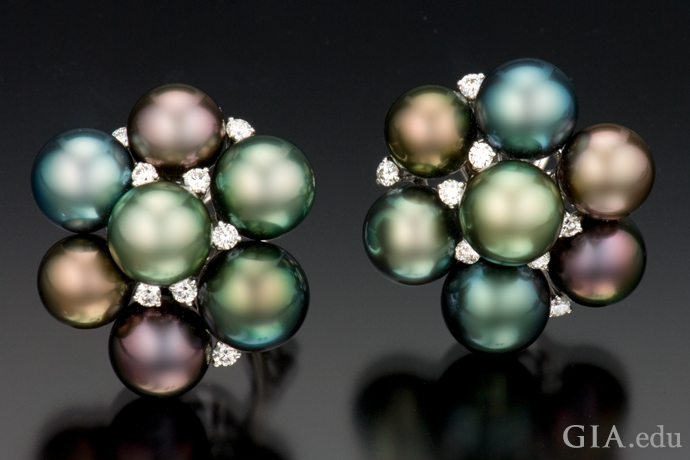
Take special care when cleaning pearl jewelry like these diamond and Tahitian cultured pearl earrings. Photo: Robert Weldon/GIA. Courtesy: Mastoloni, New York
June Birthstone: Pearl Care and Cleaning
Pearls are 2.5 to 3.0 on the Mohs Scale of hardness, so they are a comparatively soft gem and require special care. Store them separately from other gemstones and metal jewelry to prevent scratching. Never store pearls in a plastic bag — plastic can emit a chemical that will damage their surface. Always apply perfume, hair products and cosmetics before putting on your pearl jewelry. The best way to clean your June birthstone: Use a soft, damp cloth, ideally after each time they are worn.
Read more tips on how to care for pearl jewelry to keep your watery treasures beautiful.
June is a month for celebrations, be it weddings, anniversaries, graduations or birthdays. And what better way to celebrate than with the June birthstone. From a classic strand of akoya cultured pearls to a single faceted Tahitian cultured pearl, there’s a look for every taste and budget.
Pearls are trending. Five Easy Pieces shows how to wear them with style.
